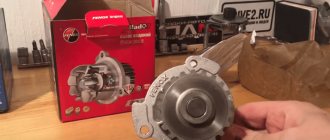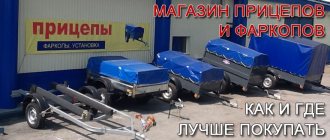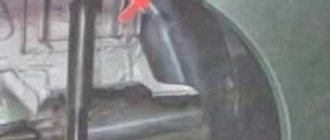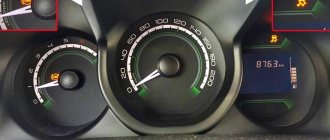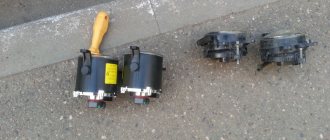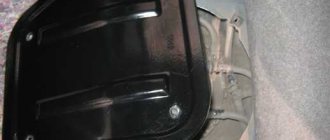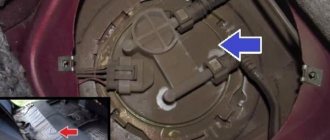Purpose of the water pump
The main function of the water pump is to maintain the timing belt and move antifreeze through the engine cooling system. In turn, the cooling system is designed to ensure the required circulation of antifreeze, cooling the power unit and providing its parts with protection from possible overheating. The lack of cooling makes the normal functioning of the motor impossible, since even minimal loads in this case lead to instant heating and subsequent boiling of the power unit.
The pump operates thanks to the drive from the timing belt. The operation of the entire cooling system is structured as follows: first, coolant is poured into the expansion tank, and after the engine is started, it enters the pump cavity. The pump operates in a temperature range from - 40oC to + 40oC with air humidity up to 90%.
Installing a new timing belt
We take out a freshly purchased set.
Timing kit.
Important! The tensioning direction is indicated on the timing belt tension roller, do not confuse it.
Tension direction.
We check that all marks match and install the tension roller; do not tighten the bolt. We install the new timing belt first on the crankshaft sprocket, then on the camshaft, tension roller and pump. The belt section between the camshaft and crankshaft sprockets must be tensioned. Pull the tension roller until the marks match and tighten the bolt.
Correct tension.
Once again we check that the marks match, after which we turn the crankshaft two turns and check the tension. If the tension is weakened, tighten it.
Installed belt.
We install all parts in the reverse order of removal. Fill with antifreeze. That's all! By the way, the engine is identical to that installed on the second generation Kalinas; replacing the timing belt on them is described in this article.
Symptoms of pump failure
The resource of a modern water pump of a VAZ injection engine averages from 40,000 to 50,000 km. Pump failures caused by its operation are diagnosed quite simply. To determine the causes of the malfunction, you will need to visually inspect the CO section of the water pump, or completely dismantle this section. The most typical symptoms of a malfunction include:
- leaks in the area where the water pump is located;
- the coolant level in the tank drops sharply;
- the motor begins to heat up rapidly;
- At the location of the pump there is noise and humming of the bearings.
Tests and tests
Experts from the Za Rulem magazine tested 36 drive belts - 6 copies of each from six different brands. The test results refer to specific product samples and do not allow us to judge the entire range of products of each item.
Recommended:
- Continental, Germany. Approximate price 850 ₽. There can be no complaints about a belt that has stood for 400 hours on the stand and could continue to work. In our tests, only two products were able to demonstrate this.
- Gates, UK. Approximate price 1150 ₽. 400 hours on the bench are sufficient grounds for unequivocal approval.
- Trialli, China. Approximate price 700 ₽. 286 hours is, let’s say, a strong middle peasant, which, unlike the leaders, nevertheless became toothless, although it lasted quite a long time, exceeding the requirements of the technical specifications. At the same time, strength tests have shown that some belt parameters are even better than those of the champions.
Description of the replacement process
Grants are equipped with eight and sixteen-valve engines. The water pump is located under the timing belt casing, and therefore when dismantling it, both casing covers, the belt, the tension roller and the crankshaft pulley are removed. The slight differences in the procedure for changing the pump for an eight- and sixteen-valve power unit lie in the different methods used when dismantling and subsequently installing the timing belt, which will be discussed in more detail below.
The cost of the pump varies from 1000 to 2000 rubles. For 1000 rub. the owner of the Grant will be able to purchase a water pump manufactured at AvtoVAZ. More expensive pumps are imported analogues that have an increased service life. In addition, there are also pumps on the market that cost from 500 to 700 rubles, but most often they are sold by not very conscientious sellers who pass off their product as an original, which it actually is not. Installation of such parts is highly undesirable.
It is also worth noting that when purchasing a new element, the car owner should focus on the type of engine for which this part is intended, since pumps for 8- and 16-valve Grants are not interchangeable. There are markings on the pump packages that allow the buyer to select the part that is suitable for his type of motor.
Article numbers of original parts
Lada Granta, Kalina with 8-valve engines (VAZ 11183):
Timing kit 2108 - 21080100604086 (Gates CIS LLC, Moscow). The kit includes a belt and a roller. This is the GATES K015521 kit, only in LADA branded packaging.
Lada Granta, Kalina, Priora with 8-valve engines (VAZ 11186, 11189)
:
- Toothed belt assembly - 21116100604000 (Gates CIS LLC, Moscow)
- Toothed belt assembly - 21116100604082 (Gates CIS LLC, Moscow)
- Tension roller - 21116100623800 (Gates CIS LLC, Moscow)
- Tension roller - 21116100623882 (Gates CIS LLC, Moscow)
Timing kit - 21116100604086 (Gates CIS LLC, Moscow). The kit includes a belt and a roller. This is the GATES K015670XS kit, only in LADA branded packaging.
Lada Granta, Kalina, Priora, Largus Vesta, XRAY with 16-valve engines (VAZ 21126, 21127, 21129 and 21179)
:
- Reinforced toothed belt - 21126100604000 (Gates CIS LLC, Moscow)
- Reinforced toothed belt - 21126100604082 (Gates CIS LLC, Moscow)
- Toothed belt - 21126100604001 (ContiTech Antriebssysteme GmbH)
- Support roller - 21126100613500 (“Lada Holding” GMBH Vienna)
- Support roller assembly - 21126100613501 (Schaeffler Technologies GmbH & Co. KG)
- Automatic toothed belt tensioner - 21126100623800 (“Lada Holding” GMBH Vienna)
Timing kit 21126 - 21126100604086 (Gates CIS LLC, Moscow). The kit includes a belt and 2 rollers. This is the GATES K015631XS kit in LADA branded packaging, which is installed on the AVTOVAZ conveyor.
Timing drive kit VAZ 21179 for Lada Vesta, XRAY - 21177-1006040-86 (Belt - ContiTech, rollers - Schaeffler):
- Belt Contitech 21126-1006040-01
- Automatic toothed belt tensioner 21176-1006238-00 (Slovakia)
- Support roller assembly 21126-1006135-01 (Germany)
Instructions for changing the pump on Grant
Even before starting work, the car owner is recommended to read the machine’s operating manual; this will help you study the structure and location of the water pump in more detail. Remember - incorrect reassembly will lead to damage to the antifreeze in the system.
Then you need to prepare a place to work; normally this should be a dry box with a flat floor. Take care of good lighting, this will not only make the process easier, but will also insure you against the loss of small fasteners and small parts.
At the very beginning of work, the car is de-energized by removing the terminals from the battery. In addition, the car is securely secured using parking shoes or a hand brake. All these manipulations are carried out to ensure maximum safety and convenience of the work process.
When replacing, it is extremely important not to deviate from the sequence of actions given below, since violation of the described order of work can cause a breakdown of the cooling system and lead to a fire in the car.
Replacing the pump itself will require you to do the following:
- First you need to completely drain the coolant;
- Next, unscrew the fastening elements and dismantle the front cover of the timing case;
- Then fix the piston of the first cylinder at top dead center;
- The car is put into gear;
- A jack is used to lift the front wheel of a car;
- The wheel rotates until the mark on the pulley coincides with the mark located on the rear timing housing cover;
- Work is being done to dismantle the timing belt, the tensioner pulley is dismantled;
- The rear cover of the timing case is removed;
- The fastening elements securing the water pump are unscrewed;
- The element is carefully pryed off with a screwdriver, after which it is removed;
- In the future, you should install a new pump and previously dismantled elements and assemblies, performing actions similar to dismantling, but in the opposite order.
- Before installing a new pump, the mating surface of the cylinder block is cleaned of the remnants of the previous gasket and a new one is installed in its place, having first applied a thin layer of waterproof sealant to it. The drainage hole on the water pump body should be directed downwards after installation;
- The last stage of the work process involves pouring coolant into the cooling system.
- The liquid is filled to a level 25-30 mm below the maximum mark on the tank, this is approximately 8 liters of antifreeze. The work is done.
Preparatory operations, all engines
Before carrying out any work, disconnect the battery terminal (key 10), as well as the DPKV sensor. But first you need to remove the protective cover.
Unscrew the 4 bolts and remove the protection
To remove protection you need:
- 11186/21116 - using a “5-point hexagon”, unscrew the 4 bolts on the upper part, which is then removed. And the lower part is also dismantled;
- 11183 – use a 10mm wrench to unscrew the 3 fastening bolts.
It will not be difficult to cope with what is said above.
Disconnect the connector, unscrew one screw
The crankshaft position sensor (CPS) is disconnected from the connector (see photo). Then the fastening screw is unscrewed with a “10” wrench. The sensor itself must be removed.
Installation of all shafts according to marks
First check that the gear is in neutral. There is a rubber cover on the crankcase body closer to the clutch assembly. It needs to be removed.
Inspection window and rubber plug
The point is to achieve alignment of the marks on the flywheel and in the scale slot. When this is done, fix the flywheel with a screwdriver.
Flywheel fixed
Of course, it is easier to perform such an operation with two people. Know that the desired position of the shaft corresponds to the alignment of marks AB and CD (see figure).
Timing drive in 8-valve engines
The crankshaft itself must be rotated to the right using a 17 or 19 key (motor 11183). The meaning of this is illustrated in the photo.
You need to turn the generator drive pulley
The alternator belt needs to be removed
The alternator belt blocks access to the timing drive parts. You will have to loosen the fastening and remove this belt.
More about this:
Generator mounting, 13 bolts
Use a 13mm wrench to loosen the lower mounting bolt. Then unscrew the upper fastening nut and remove the bolt. The generator casing is pressed against the engine and the structure is secured with wire.
The belt can now be removed.
Installation of the alternator belt is carried out in the following sequence:
Please be aware that reusing the alternator belt is a last resort. It would be better to buy a new part.
Parts from the VAZ catalog
Let’s immediately look at the list of VAZ components and special tools:
- Tensioner roller for internal combustion engine 11183 – 2108-1006120, nut for it – 00001-0021647-21;
- Timing belt (11183) – 2108-1006040-10;
- Automatic tension roller – 21116-1006226;
- Timing belt (11186/21116) – 21116-1006040;
- Key for automatic roller – 67.7812.9573-01;
- Key for roller VAZ-11183 – 67.7834.9525.
The tension roller of the "2108" family has two slots on one side. These slots should look “up”, that is, away from the engine.
Tensioner roller for motor 11183
The slots were made for special tools. It is designated by the numbers “67.7834.9525” (see list). And for automatic rollers, the key is designated differently - “67.7812.9573”. What it looks like is shown below.
The automatic roller can also be adjusted
It remains to list how the mounting bolts, washers, etc. are designated:
- Three bolts for the VAZ-11183 cover – 00001-0009024-11, washers – 00001-0026406-01;
- Timing drive cover (11183) – 21080-1006146-10;
- Bolts for VAZ-21116 covers – 2108-1003286-00, spring washers – 00001-0011977-73;
- Top cover – 21116-1006226-00, bottom cover – 21116-1006218-00.
We hope no questions arise here.
